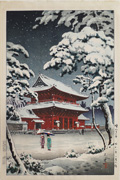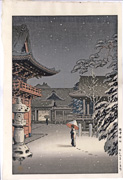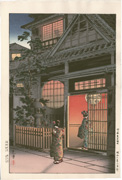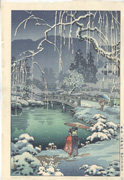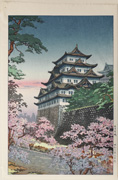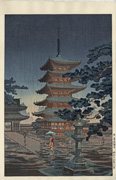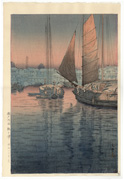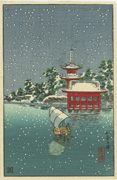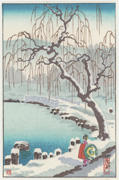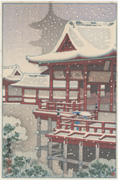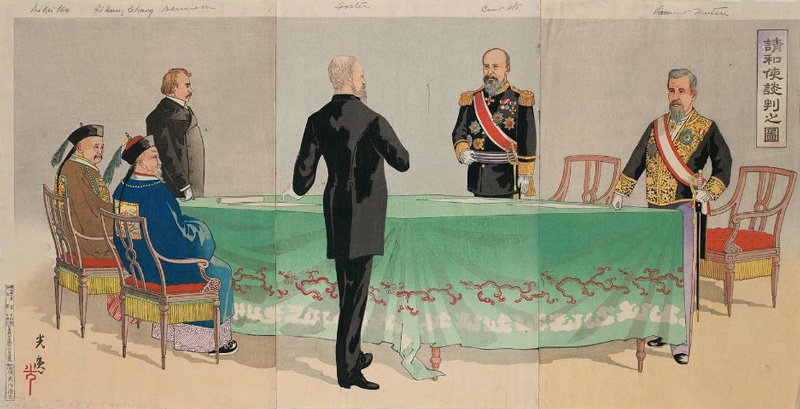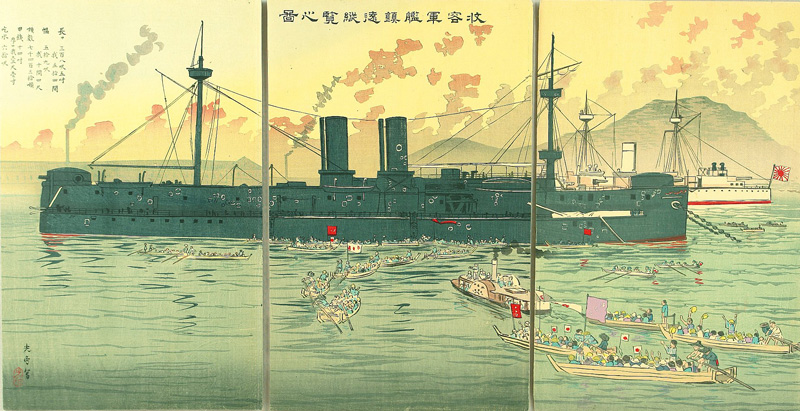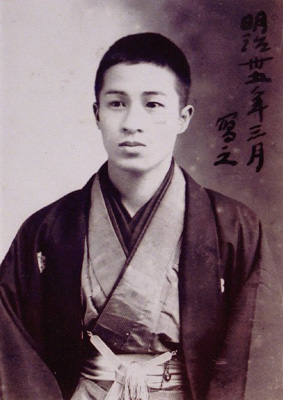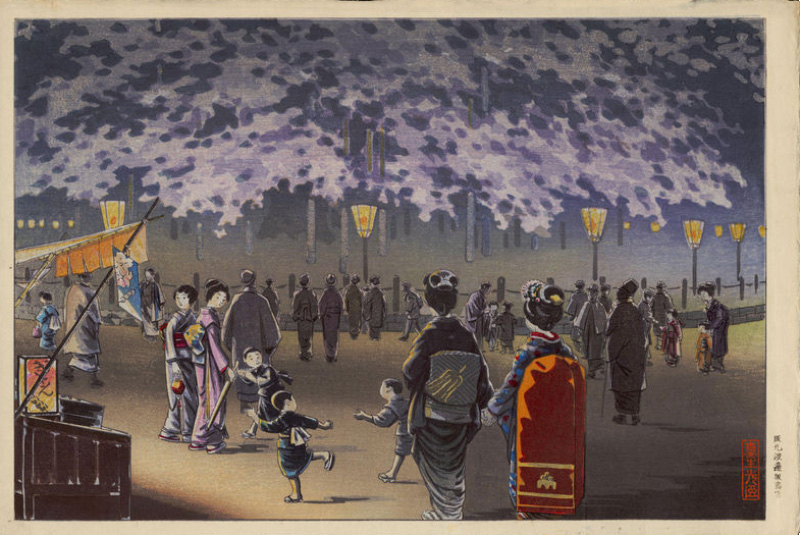Prints in Collection
Zōjōji Temple in Snow, 1933
IHL Cat. #978
Nagoya Caste, 1937
IHL Cat. #981
Nara Hōryūji, 1938
IHL Cat. #1141
Seto Inland Sea, Tomonotsu, 1940
IHL Cat. #1517
Wakanoura,
undated (c.1930s)
postcard-size print
IHL Cat. #658
Kyoto Maruyama,
undated (c. 1930s)
postcard-size print
IHL Cat. #1419
Kyoto Kiyomizu,
undated (c. 1930s)
postcard-size print
IHL Cat. #1427
Biographical Data
Profile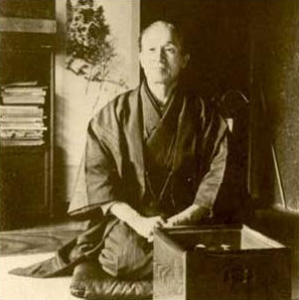 undated photo of artist | Tsuchiya Kōitsu 土屋光逸 つちや こういつ Tsuchiya, one of the few students of the famous Meiji-era print designer Kobayashi Kiyochika (1847-1915), was primarily known as a landscape artist who designed shin hanga (New Prints) for some of the major woodblock print publishers, from the early 1930s until 1940. Critics hold opposing views of his shin hanga designs, praising him for his “dramatic use of light”1 and “interesting color effects”2 (attributed to the influence of his teacher), and lambasting him for his “characteristic heavy-handed design and odd color sensibility.”3 Today his landscape prints are considered by many collectors on par with those of the most famous shin hanga landscape artists Kawase Hasui (1883-1957), Kasamatsu Shiro (1898–1991) and Yoshida Hiroshi (1876-1950).(1870-1949) 1 Guide to Modern Japanese Woodblock Prints: 1900-1975, Helen Merritt, University of Hawaii Press, 1992 2 Japanese Wood-block Prints, Shizuya Fujikake, Japan Travel Bureau, 1953, p. 93. 3 Shin-Hanga: New Prints inModern Japan, Kendall Brown, Hollis Goodall-Cristante, Los Angeles County Museum of Art, 1996, p. 71. |
Sources: “Tsuchiya Kōitsu (1870-1949), An Artist’s Journey,” Ross F. Walker and Toshikazu Doi, Andon 89, Society for Japanese Arts, The Netherlands, December 2010 and “Publishers of Tsuchiya Kōitsu Works,” ,” Ross F. Walker and Toshikazu Doi, Andon 91, Society for Japanese Arts, The Netherlands, December 2011 and as footnoted.
Note: The most comprehensive account of Tsuchiya Kōitsu’s life can be found in the December 2010 issue of Andon (number 89), the bulletin of the Society for Japanese Arts, in the article “Tsuchiya Kōitsu (1870-1949), An Artist’s Journey,” by Ross F. Walker and Toshikazu Doi and in their follow-up article “Publishers of Tsuchiya Kōitsu Works,” appearing in Andon 91, issued in December 2011.
Born Tsuchiya Sahei on August 28, 1870 into a farming household in the Hamamatsu area of Shizuoka Prefecture about 150 miles southwest of Tokyo, Kōitsu moved to Tokyo at the age of fifteen to train at a temple. His artistic talent must have been recognized by the temple priest as the priest arranged for him to take an apprenticeship with the engraver Matsuzaki Shūmei, an associate of Kobayashi Kiyochika (1847-1915). It was Matsuzaki who arranged for the young Kōitsu to apprentice with Kiyochika, and Kōitsu was to live in the Kiyochika household from around 1886 until 1900, when he moved into his own house. It was Kiyochika who gave the young Tsuchiya the artist name (gō) Kōitsu. While a student of Kiyochika, Kōitsu designed his first commercial prints. The below triptychs of scenes from the Sino-Japanese War of 1894-1895 are early works of the artist published by Takekawa Seikichi (Sawamuraya Seikichi) and Inoue Kichijirō, both of whom also published works by Kiyochika.
Japanese Representatives Meet with a Chinese Peace Mission Seiwashi danpan no zu 請和使談判之図
Japanese, Meiji era, 1895 (Meiji 28)
Tsuchiya Kōitsu, Japanese, 1870–1949
Publisher Takekawa Seikichi (Sawamuraya Seikichi),
Museum of Fine Arts, Boston RES.27.160a-cChinese Warship Ting Yuang Visiting Japan, 1895
Tsuchiya Kōitsu, Japanese, 1870–1949
Publisher Inoue KichijirōIn the years after leaving the Kobayashi household in 1900, Kōitsu worked for the publisher Shōbidō Tanaka creating a variety of art including paintings for hanging scrolls, woodblock prints and what Walker and Doi refer to as “machine printed items.” Walker traces this relationship back to as early as 1904 and it was to last into the 1940s, providing a major source of work and income for Kōitsu.
Kiyochika’s daughter, Kobayashi Katsu, remembers Kōitsu as “a good-looking man…skilled at drawing and sketching” who “became an indispensable member” of her family.1 Kōitsu and Kiyochika were to maintain a close relationship until Kiyochika’s death in 1915.
It is likely that Kōitsu learned lithography while studying with Kiyochika, as Katsu remembers the artist “busy with his lithograph works…from around 1895 onward.”2 Walker and Doi find evidence for Kōitsu creating “as many as one hundred lithographic prints…”3 until the artist had to give up lithography due to a bout with pleurisy around 1905, shortly after his first marriage. Unfortunately, his first wife was to pass away in 1911.
Kōitsu was to marry again, sometime between the passing of his first wife and the birth of his daughter Masa in 1920, to Suzuki Masu, who he first met in Chikasagi where he went for treatment of pleurisy. Misfortune again struck Kōitsu, as Masu was to die of complications from her pregnancy and care of the child fell to Masu’s younger sister Toyo, who Kōitsu was to marry in 1924, the year after the Great Kanto Earthquake.Landscape Prints
Kōitsu came to landscape prints late in his career, at the age of 61, and while a contemporary of Hasui and Kasamatsu he is considered a second generation shin hanga artist. His first recorded landscape designs date from c. 1931 when he created designs for both the Tokyo-based publishers Kawaguchi4 and Watanabe, the most famous of shin hanga publishers.
Kōitsu first met Watanabe Shōzaburō (1885-1962) in 1931 at a memorial exhibition for Kiyochika commemorating the seventeenth anniversary of his death and within several months of their meeting Watanabe published the first of ten prints by the artist, Cherry Blossom Viewing in the Evening at Gion, which Merritt describes as follows:
Cherry Blossom Viewing in the Evening at Gion, 1932
1 Andon 89, “Tsuchiya Kōitsu (1870-1949), An artist’s journey”, Society for Japanese Arts, The Netherlands, December 2010, p. 27.
Cherry Blossom Viewing was shown at Watanabe’s Third Modern Woodblock Print Exhibition held in Nihonbashi from April 17 to 22, 1932.
Kōitsu was to work with at least six shin hanga publishers, as summarized below:6
Note: above numbers include small format (post card)prints.
As can be seen in the above chart, the vast majority of the artist’s prints were published by Doi Hangaten, starting in 1933. Walker and Doi find that “the prints published under Doi Sadaichi were superior because their carving and printing quality faithfully illustrated Kōitsu’s drawing expertise and style at his best.”7 They go on to state that “His landscape prints which expressed the true essence of the depicted scene reached their pinnacle in the twelve masterpieces known as the Tokyo Views series,”8 one of which, Zozoji Temple in Snow, in a later edition, is part of this collection. Doi Hangaten continues to this day to re-publish prints by the artist.
With the advent of Word War II, both sources of Kōitsu’s income, which depended heavily on the export market, declined (his paintings of hanging scrolls exported to China and his woodblocks bound for the West.)9 After the war the artist continued with his painting until his death on November 13, 1949 from complications due to pneumonia, but he did not create any new shin hanga.
Kōitsu was to work with at least six shin hanga publishers, as summarized below:6
| Publisher | Number of Prints (approx.) | Period of Artist's Design (approx.) |
| Watanabe Printing Co. Ltd. (Watanabe Shōzaburō) | 10 | 1932-1940 |
| Tokyo Shōbidō (Shōbidō Tanaka) | 53 | late 1930s-early 1940s |
| Kawaguchi Shōkai (Kawaguchi Shōzō) | 3 | early 1930s |
| Doi Hangaten (Doi Sadachi) | 135 | 1933-1940 |
| H. Takemura Shōkai (Takemura Hideo) | 52 | 1930s |
| Tokyo Hanga-in (Baba Nobuhiko) | 22 | 1936-1941 |
As can be seen in the above chart, the vast majority of the artist’s prints were published by Doi Hangaten, starting in 1933. Walker and Doi find that “the prints published under Doi Sadaichi were superior because their carving and printing quality faithfully illustrated Kōitsu’s drawing expertise and style at his best.”7 They go on to state that “His landscape prints which expressed the true essence of the depicted scene reached their pinnacle in the twelve masterpieces known as the Tokyo Views series,”8 one of which, Zozoji Temple in Snow, in a later edition, is part of this collection. Doi Hangaten continues to this day to re-publish prints by the artist.
With the advent of Word War II, both sources of Kōitsu’s income, which depended heavily on the export market, declined (his paintings of hanging scrolls exported to China and his woodblocks bound for the West.)9 After the war the artist continued with his painting until his death on November 13, 1949 from complications due to pneumonia, but he did not create any new shin hanga.
Sample Signatures and Seals
 光逸画 光逸 |  光逸 光 |  光逸 真 |  光逸 光逸 | 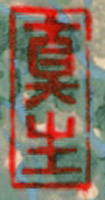 Shinsei 真生 |  真生光逸 |  真生 |
 Kōitsu Kōitsu光逸 |  Kōitsu Kōitsu光逸 |  Kōitsu Kōitsu光逸 |
1 Andon 89, “Tsuchiya Kōitsu (1870-1949), An artist’s journey”, Society for Japanese Arts, The Netherlands, December 2010, p. 27.
2 Ibid. p. 28.
3 Ibid.
4 Walker and Doi find that the Kōitsu prints often attributed to the publisher Sakai-Kawaguchi should be attributed to Kawaguchi Shōkai.
5 Modern JapaneseWoodblock Prints - The Early Years, Helen Merritt, University of Hawaii Press, 1998, p. 64-65.
6 Derived from Andon 91, “Publishers of Tsuchiya Kōitsu works,” Ross F. Walker and Toshikzau Doi, Society for Japanese Arts, The Netherlands, December 2011, p. 39.
7 Op. cit. Andon 89, p. 36.
8 Ibid.
9 Ibid.
